Pothos, the famously foolproof and devilishly delightful family of plants.
Perfect for obsessive plant collectors and beginner houseplant dabblers alike, these eclectic tropical plants comes in all manner of shapes, stunning colours and stylish patterns.
Not to mention, they’re outrageously easy to take care of – to the extent that if you managed to destroy one I’d genuinely be impressed. Horrified, but impressed.
Originally from South Pacific archipelagos, Pothos (aka Devil’s Ivy) is an invasive vine that will take over your heart, and turn your home into a tropical paradise.
We’ll be going through each variety, looking at some of its standout distinctive features and linking to our specific care guides where applicable. Let’s do this thing!
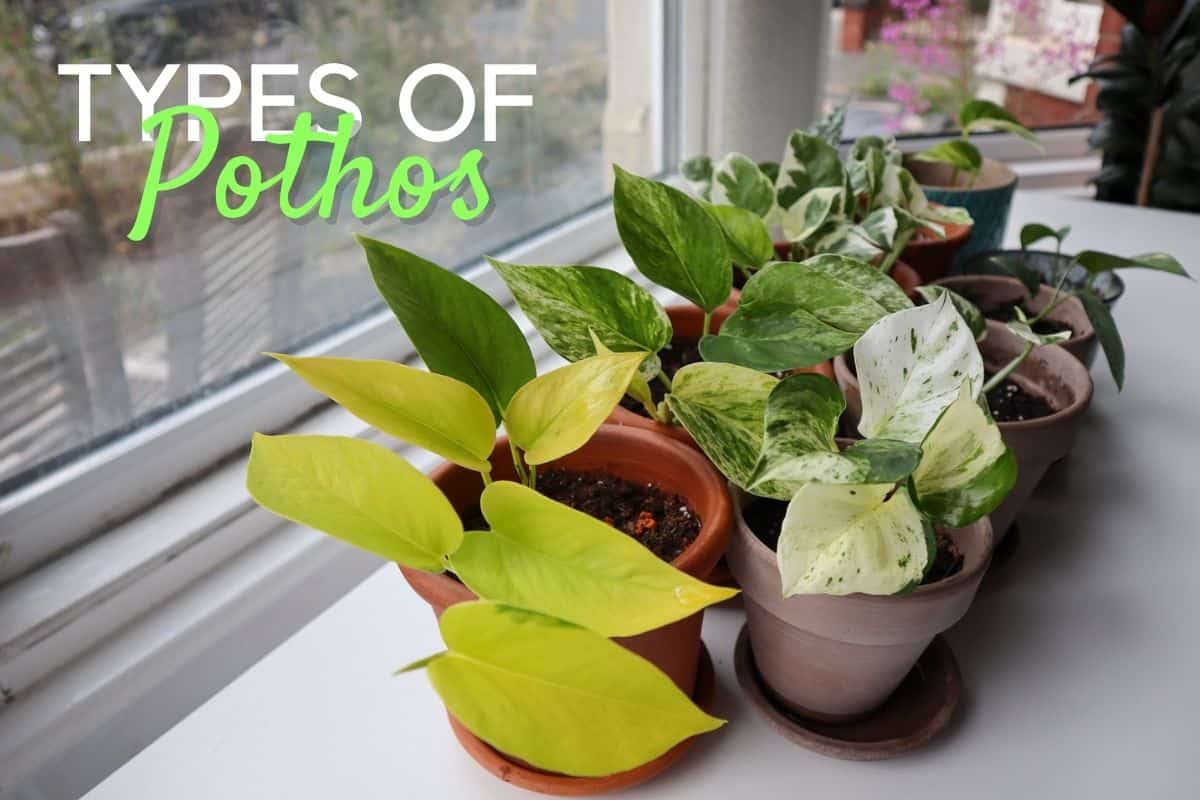
Terrarium Tribe is reader-supported. When you purchase through links on our site, we may earn an affiliate commission (at no further cost to you). 💜
The Four Original Types of Pothos
Let’s start at the very beginning with the four truly classic Pothos.
Or, as I like to call them – the Four Horsemen of the Apothoslypse.
And yes, if you’re here for a serious article, now is the time to run away…
These guys are the varieties found in nature, and they all have a similar leaf shape, care requirements, and growth rate (not too dissimilar from the speed of light).
And when I say Pothos, I’m specifically talking about Epipremnum aureum.
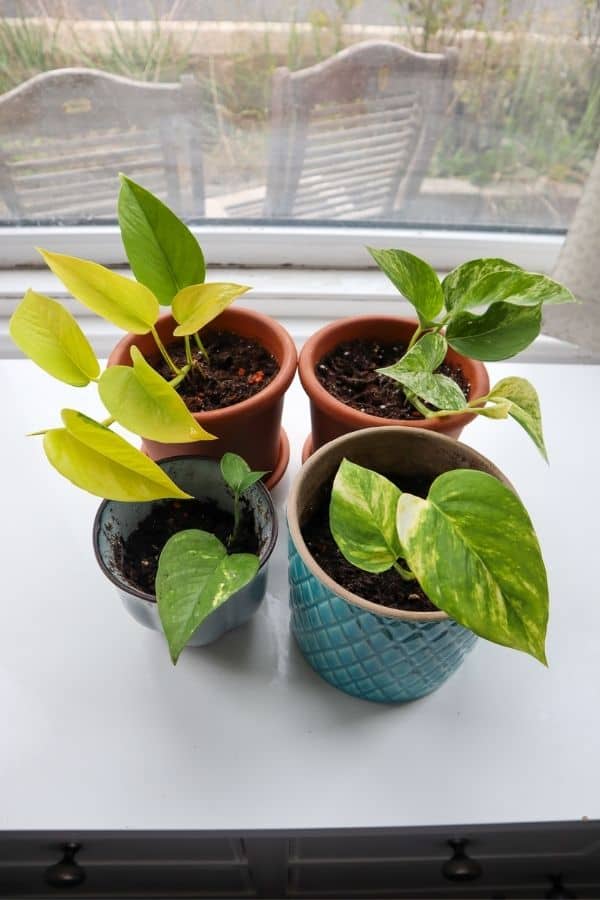
Over the years, there’s been a lot of drama around what classifies as a Pothos, so I’m keeping things neat and tidy and sticking to this genus (with the exception of a worthy stowaway or two at the end of this list).
So, I’ll cover the classics first, and then we’ll dive into the newer varieties. Oh, and if you’re a sucker for variegated plants, you’re going to LOVE this list.
1. Golden Pothos
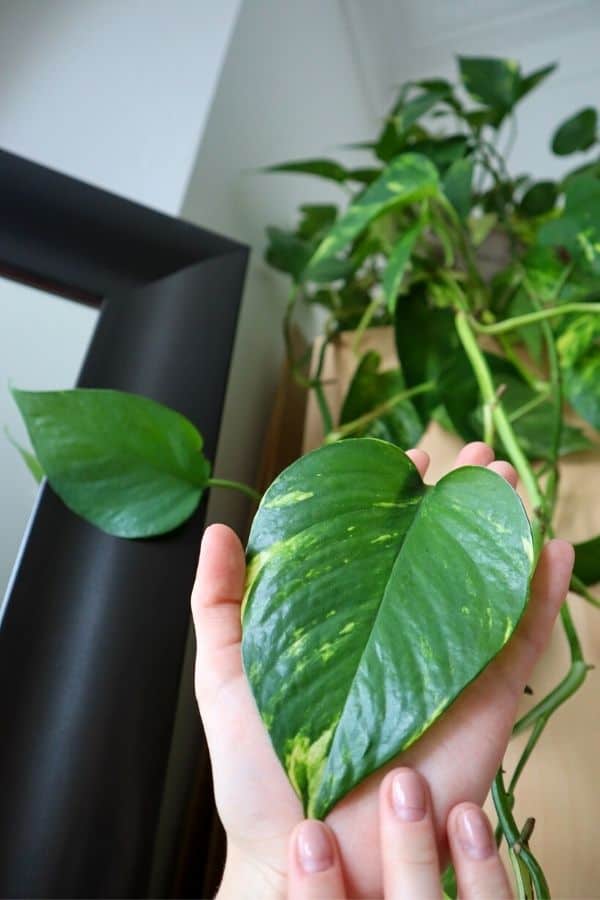
I’ve said it before, and I’ll say it again: owning a Golden Pothos is a houseplant parent rite of passage.
The Golden Pothos is easily the most common Epipremnum aureum. Hell, maybe even the most popular houseplant, and just because it’s a popular variety doesn’t mean it’s not gorgeous.
With its yummy golden yellow variegation and insane vining ability, what’s not to love?
Its variegation pattern really varies from plant to plant and leaf to leaf. From dark green leaves with just a tiny fleck of gold to leaves with just as much gold as there is green.
Some of the leaves on my plant even have the odd splash of white, too.
Generally speaking, the more bright light the plant gets, the more likely it is to pop out leaves that have more sections of variegation.
👉 Shop the Golden Pothos on Etsy.
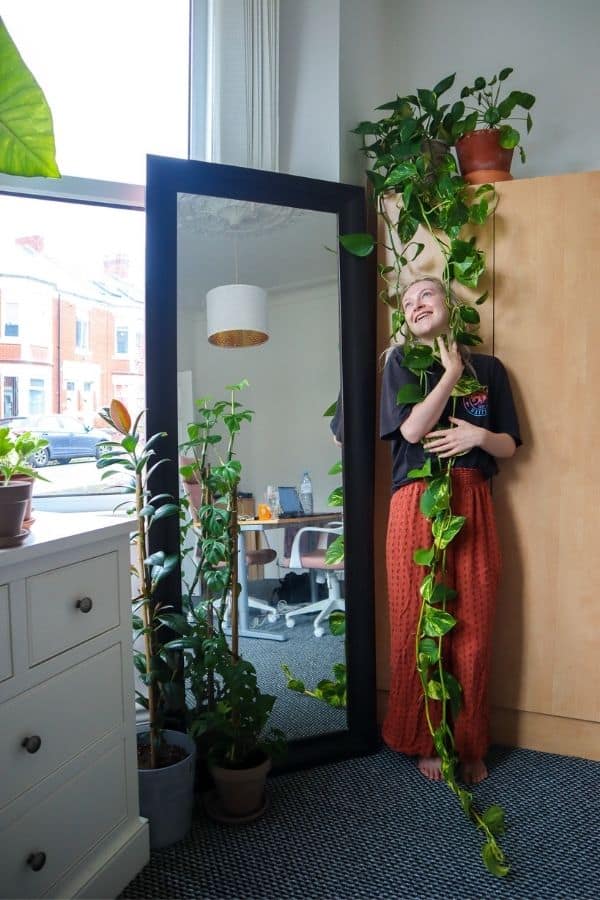
2. Jade Pothos
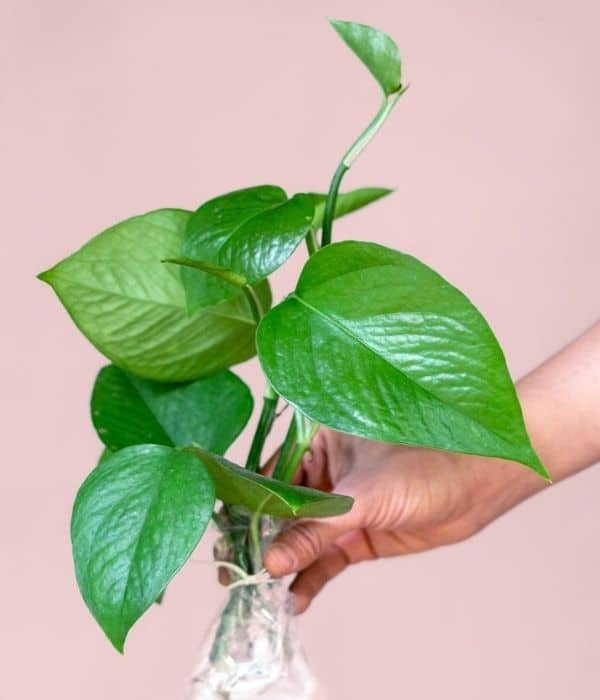
I may have my head turned by some of the shiny new cultivars, but nothing beats this classic.
There is very little that can compete with the simplistic green foliage of the Jade Pothos.
Clean, dark green leaves with no variegation whatsoever. That’s right, if it has any variegation at all, it doesn’t have Jade status!
While it’s an original Epipremnum aureum, it’s much harder to source than the variegated varieties from what I’ve found.
Which is the opposite of many tropical plants, really; think of the lengths people go to to get their hands on a variegated Monstera deliciosa!
My understanding is that the Jade and Golden aren’t technically different at all, just distinguished by the coloring and that Pothos plants must just have a high tendency for variegation.
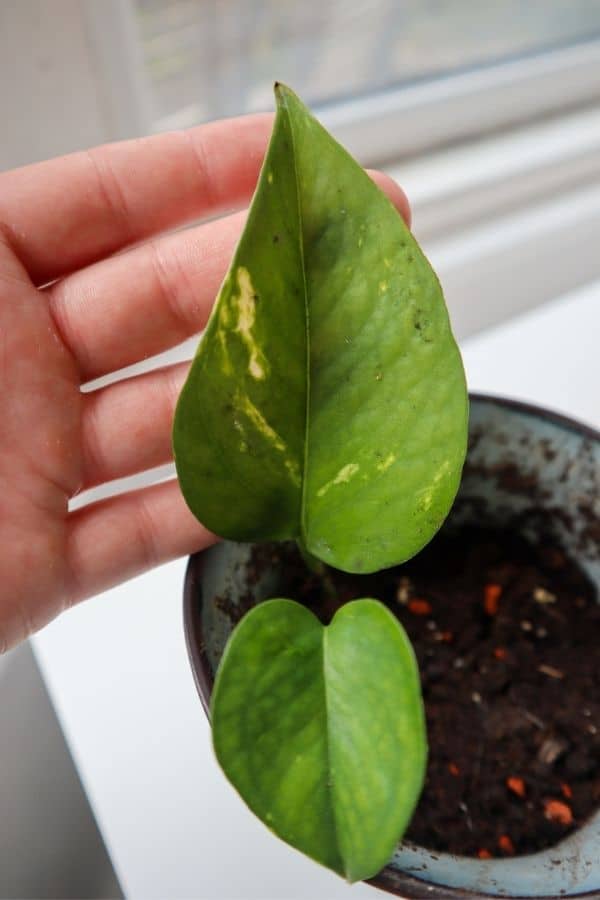
3. Neon Pothos
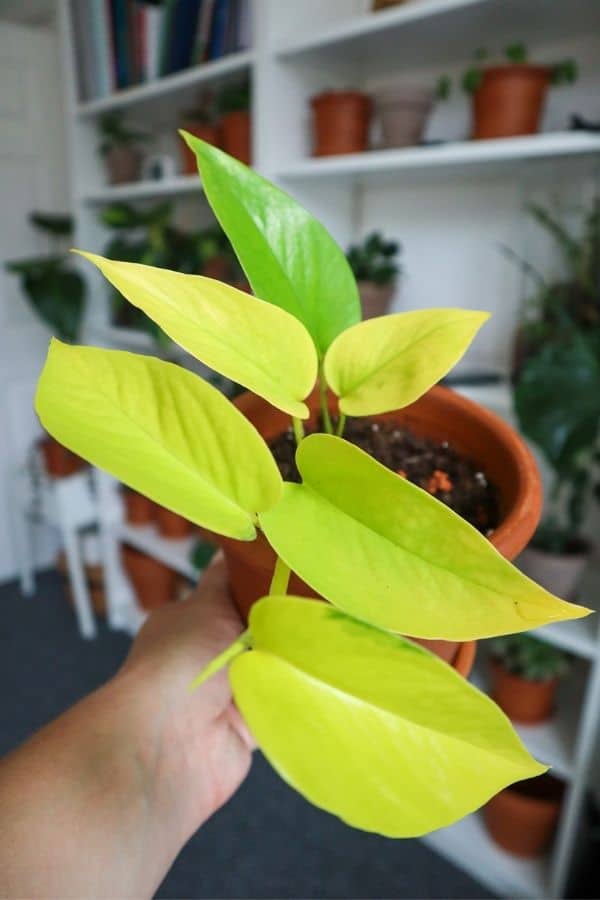
This variety of Pothos does what it says on the tin and flaunts an extremely vibrant neon green color that looks almost unnatural.
It really is the most dazzling bright shade of Pothos you can get your hands on.
The Neon Pothos stands out from the rest of my indoor plant collection and provides some much-needed vibrant contrast.
You’ll need to keep the light conditions as bright as you possibly can (while avoiding direct sunlight) in order to keep the bright chartreuse leaf color.
But other than that caveat, it’s just as easy to take care of as the rest of the Pothos plants.
You can also get Neon’s with variegated leaves if you’re extra fancy!
👉 Shop the Neon Pothos on Etsy.
4. Marble Queen Pothos
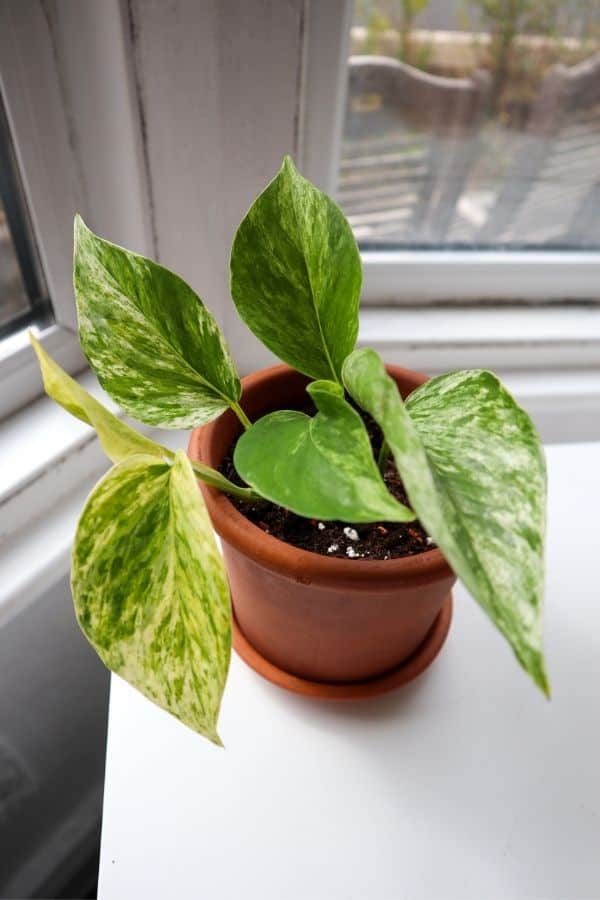
The Marble Queen Pothos is one of the most popular types, and for good reason.
Get a load of this jaw-dropping speckled variegation.
It’s covered head to toe with lovely white/cream tones but can venture into gold/yellow tone territory, too! Meaning it can occasionally look a little like a highly variegated Golden.
But the marble pattern is really marbley on a Marble Queen, with tonnes of extremely ornate little flecks, making it quite easily distinguishable.
And again, this variety will need lots of bright indirect light to keep its lovely creamy white coloring.
👉 Shop the Marble Queen Pothos on Etsy.
The Definitive List of Pothos Varieties
Now we’ve covered Epipremnum aureum 101, let’s dive into some of the snazzy newer varieties.
5. Manjula Pothos
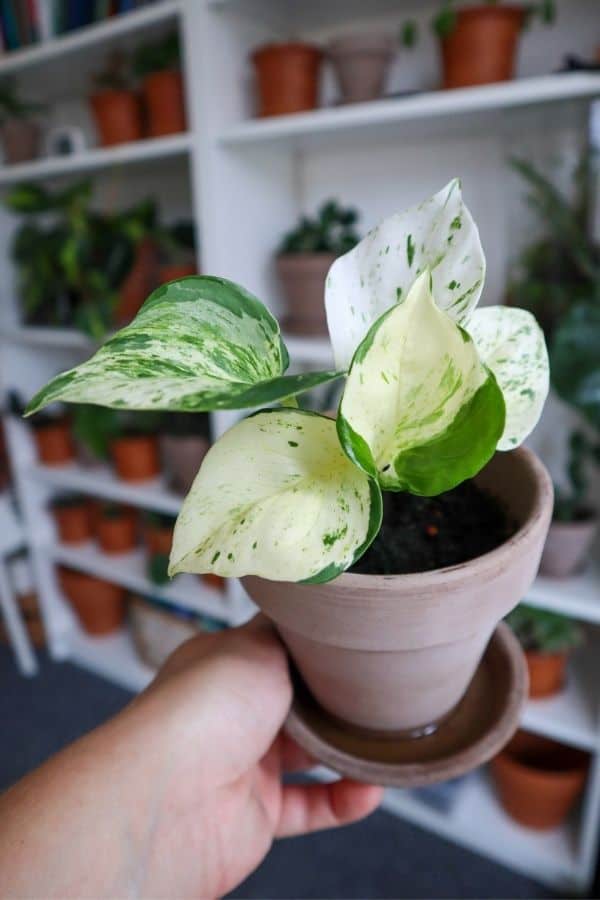
It’s time to introduce my personal favorite of all the Pothos varieties. Ladies and gentlemen… meet the Manjula Pothos!
A relatively new patented variety from Ashish Hansoti that has the most amazing variegation pattern you ever did see.
Everything from big streaks of green and white to marble and fleck patterns.
It also goes by the Happy Leaf Pothos, and with its gorgeous heart-shaped leaves, I can see why.
The Manjula has a really unique growth pattern compared to the original four cultivars, and it’s a significantly slower grower, too.
With really short internodes (making the space between each leaf really small) it’s less like a typical vining plant and has more of a mounding/compact growth habit.
👉 Shop the Manjula Pothos on Etsy.
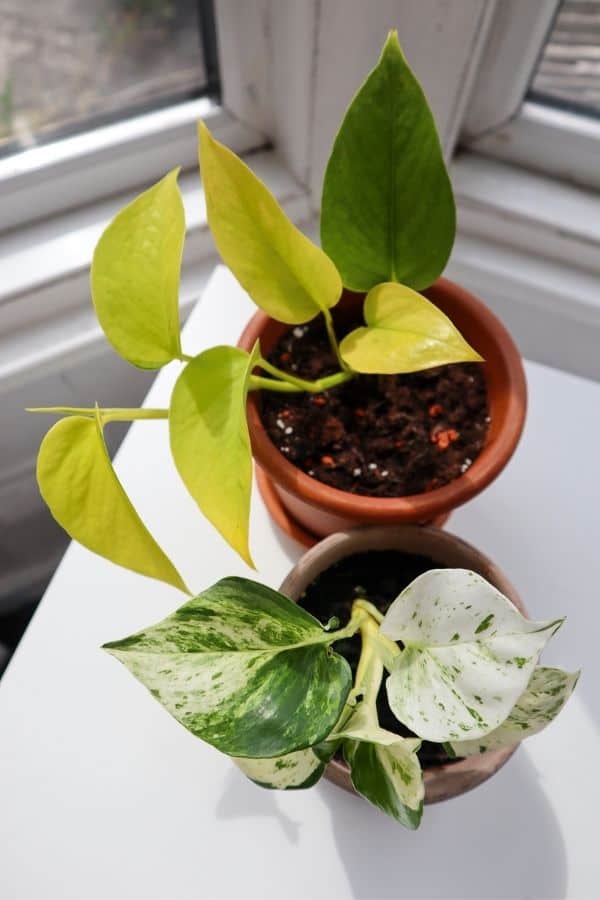
6. Jessenia Pothos
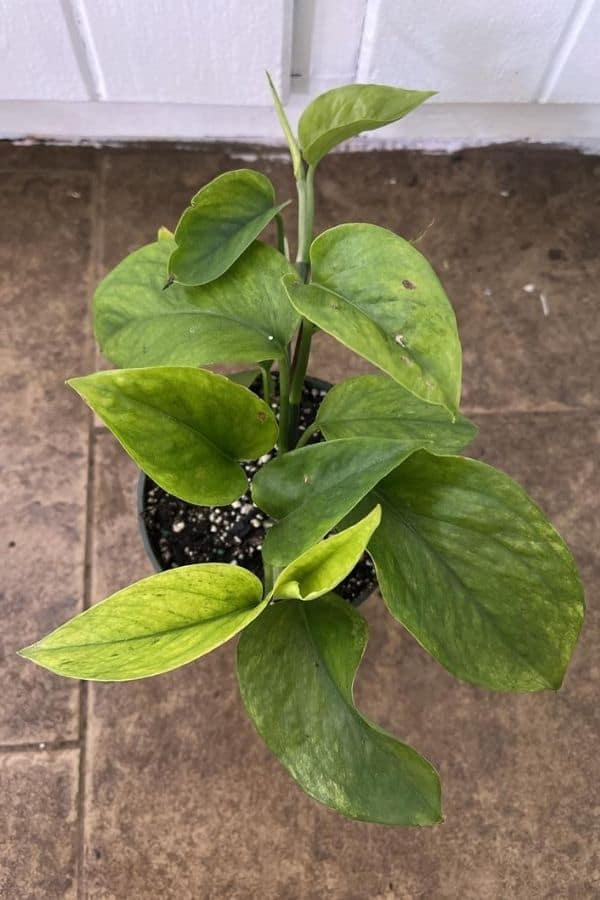
Have I managed to get my hands on this plant? No. Am I bitter about it? You bet.
With its dark green and lime green marbled variegation, it’s easily one of the most stunning varieties available, and it’s really tricky to find in the UK, unfortunately.
At first glance, it really looks similar to the Marble Queen, but it’s easily distinguished by its vibrant lime/green tones (as opposed to the cream/white/gold/green coloring of the Marble).
It looks like the Marble Queen and the Neon Pothos had a baby who luckily managed to inherit both of its parent’s most striking features.
You can also expect a leaf shape and growth pattern that’s really similar to the original four varieties, though I’ve heard anecdotal suggestions that it might grow just a little slower.
7. Njoy Pothos
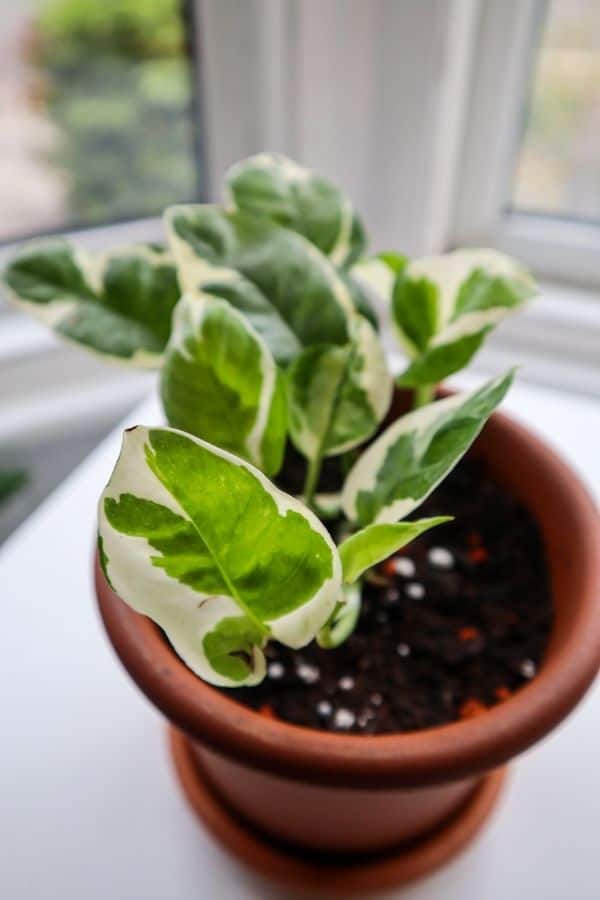
Despite having a name that makes me cringe, the Njoy Pothos is a popular variety that deserves a spot on any shelf.
This gorgeous plant has characteristic green patches and an irregular leaf shape, which really varies with each leaf.
Similar to the Manjula (but not quite as pronounced), the Njoy has short internodes, meaning it has more of a bushy growth habit.
I think it looks best with regular trimming to maintain it as a bushy plant for this reason – you’ll never quite get the most out of it as a trailing or climbing plant.
👉 Shop the Njoy Pothos on Etsy.
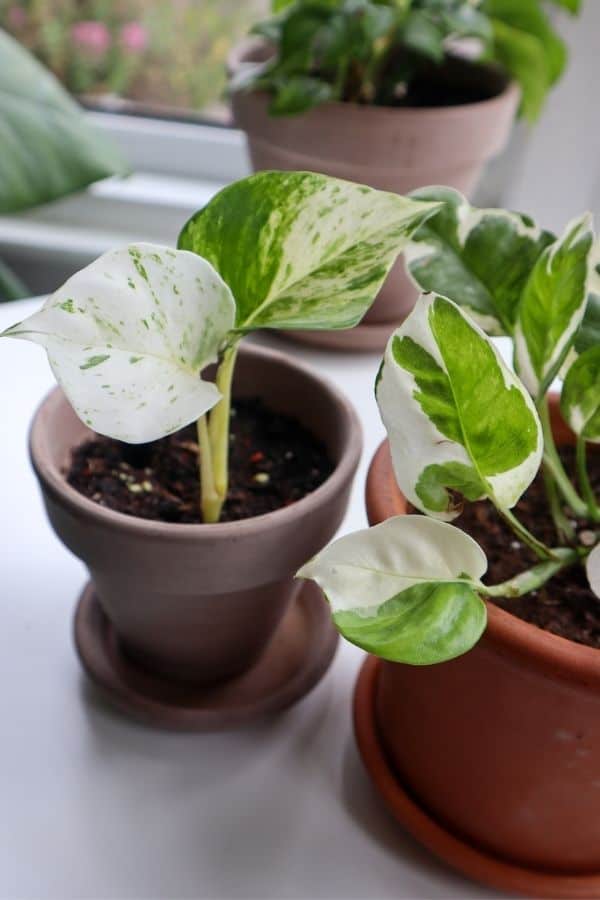
8. Pearls and Jade Pothos
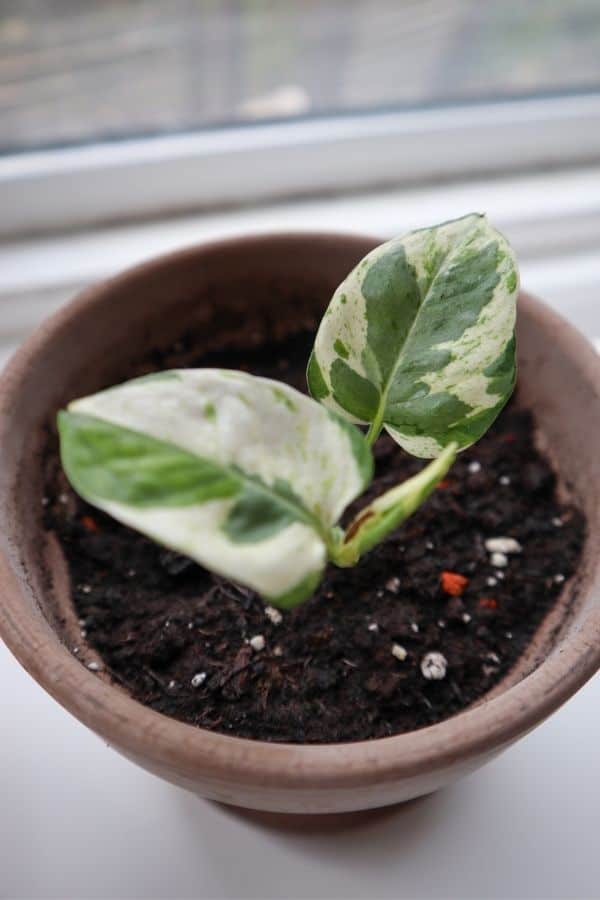
Nope, your eyes don’t mistake you – they’re almost exactly the same.
The Pearls and Jade Pothos is also a patented variegated variety; it’s a little newer than the Njoy, and this time from the University of Florida.
It has the same blotched green and white variegation, but it also has flecks similar to its Marble Queen parent.
It’s pretty much an Njoy + flecks. Both green on green variegation and green on white.
👉 Shop the Pearls and Jade Pothos on Etsy.
9. Glacier Pothos
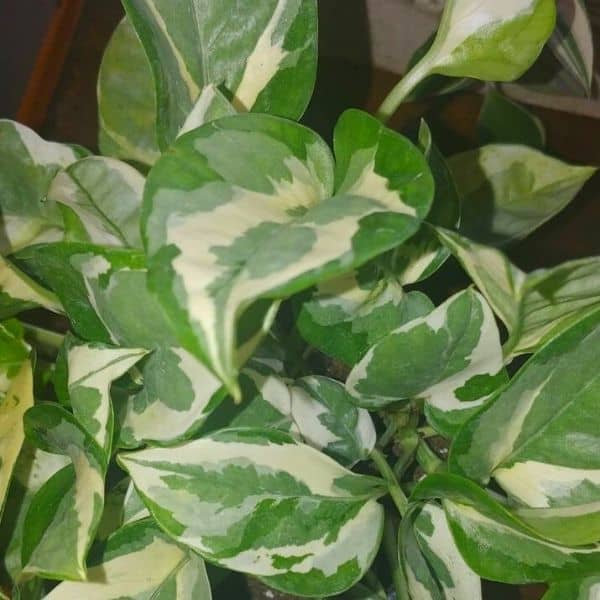
Here we go again! Honestly, these three are so similar I find it quite funny. I’m now fondly referring to them as the triplets.
The glacier is a little easier to tell apart, though. It’s arguably more grey-green in color (or at least it can be), and its leaves are a little larger and flatter than the Njoy and the Pearls and Jade.
The leaves also look thick, if you know what I mean. It reminds me a little of my Hoya carnosa Tricolour in that sense.
And while its leaf shape is irregular, it tends to be broader and pointier than its pals.
10. Global Green Pothos
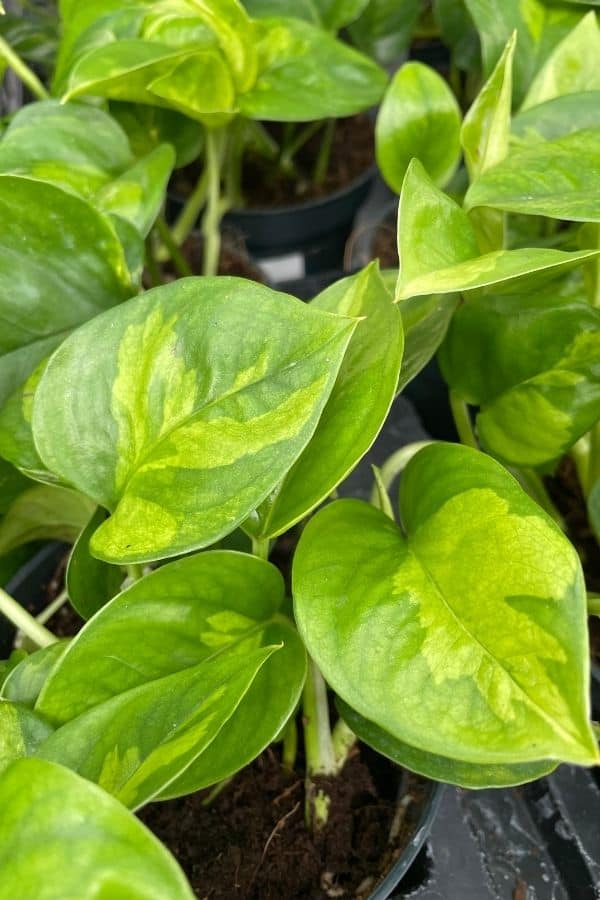
The Global Green is the new kid on the block! And it’s an absolute nightmare to get ahold of in the UK (I’d know; I’ve been endlessly scouring eBay for cuttings without avail).
It has really similar coloring to the Jessenia Pothos (bright light green, dark emerald green, and shades in between), but a blotched variegation pattern and irregular leaf shape similar to the Njoy.
It has lovely, broad, deep green, pointy leaves, with patches of lighter green spotted around, typically found more in the middle of the leaf.
As a self-confessed Pothos know it all (Pothoser if you will) I completely predict that this will be the next hot Pothos houseplant trend!
11. Emerald Pothos

Is it worth it? Let me work it: take your Global Green Pothos, flip it, and reverse it!
To the untrained eye, they look extremely alike (and unfortunately, they seem to be sold interchangeably by some sellers), but they are different varieties in their own right.
The Emerald Pothos shows off lighter green leaves with blotches of darker green variegation, typically in the middle of the leaf.
The variegation can also be a little less defined than the Global Green – with the colors often blending together a little instead of displaying harsh lines.
12. Shangri La Pothos
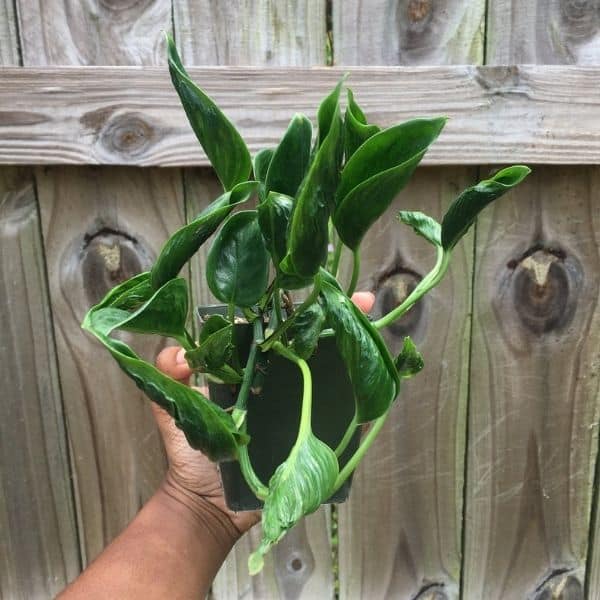
The wild card of the Pothos Plants, and one I’m very okay with not owning.
It comes in both variegated and non-variegated forms and has leaves that stand upright and curl in on themselves.
One one hand, it looks like a peace lily.
On the other hand, it looks a bit broken… Like it’s the kind of plant you’d valiantly rescue from a plant nursery only to discover that it just looks like that.
* Bonus Cebu Blue Pothos
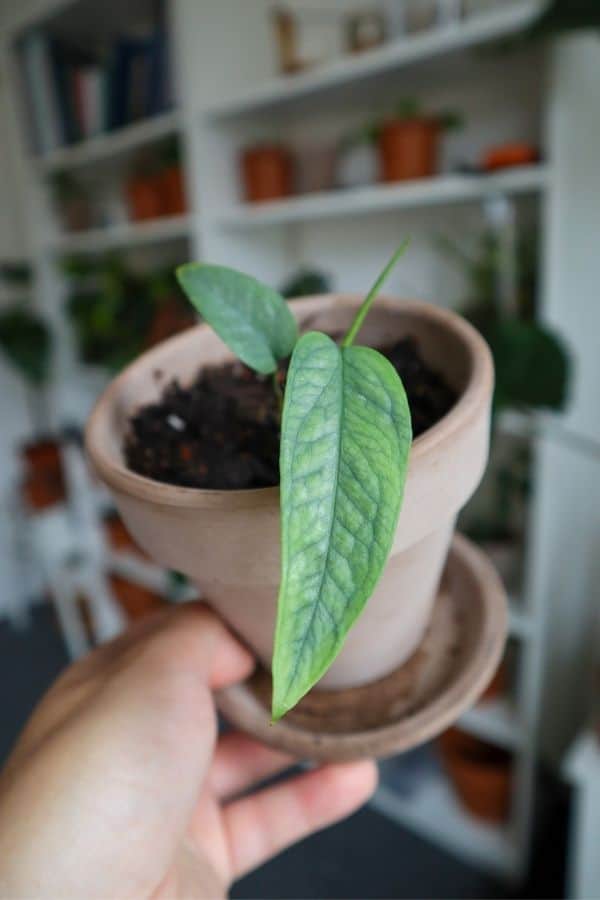
The hugely popular Cebu Blue Pothos is actually an Epipremnum pinnatum, making it the sort of distant relative of the family.
It’s still a Pothos and still deserves a place on this list, but it isn’t a part of the Epipremnum aureum gang.
It’s easily identifiable by its literally silvery blue leaves – which come in a gorgeous long, pointy lance shape.
Oh, and did I mention that mature plants can develop fenestrations if you give them a moss pole to climb!?
👉 Shop the Cebu Blue Pothos on Etsy.
* Bonus Satin Pothos (AKA Silver Pothos)
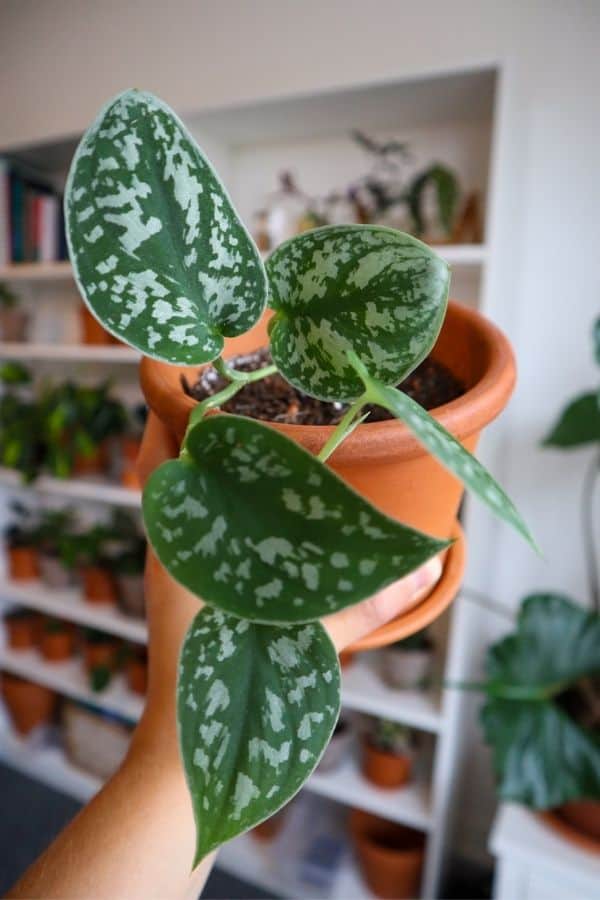
One of these is not like the others.
This little wonder (native to South East Asia) is a Scindapsus pictus.
It has velvety leaves and sparkly silver variegation. It honestly looks like a glitch in the matrix – how on earth did it evolve to be so pretty?
There are so many varieties, too – like the Silvery Ann, Silver Splash, Silver Lady, and Silver Hero.
So, if you fancy a silvery sheen, the Scindapsus pictus genus is the place to be.
While not technically a Pothos in my book, it goes by the same name and shares many of the same wonderful qualities.
A hardy plant, fast grower, captivating vine, and a very welcome intruder on this list.
👉 Shop the Silver Satin Pothos on Etsy.
What About the Hawaiian Pothos? What about the Snow Queen Pothos?
Well the jury is still out on these ones kids. But I’m firmly in camp: “They don’t exist.”
Partly because I couldn’t find any official documentation on them whatsoever and partly because they’re sold interchangeably with other varieties.
The internet seems to think there’s a Pothos variety called the Hawaiian Pothos – but I’m pretty sure that it’s just a mature Golden Pothos, with huge leaves.
I imagine the mix-up has come somewhere from the fact that the Golden Pothos is an extremely invasive tropical vine. And in many places – including Hawaii – it climbs up the native trees, matures, and even develops fenestrations.
Oh, and if you were expecting to see a Snow Queen Pothos on this list – think again.
I’ve seen plenty of evidence suggesting it’s just a sun-soaked Marble Queen. And you can, over time, get yourself a Marble Queen with brighter variegation just by giving it brighter light.
But then again, I think mutation does play a part, even if it’s not currently a separate variety that’s been specifically created or defined. It’s sort of like buying a dog – you want to check out the parent plant to see what you’re getting.
Over to You!
Phew! you made it. What’s your favorite variety?
Where do you stand on the Snow Queen/Hawaiian controversy?
Let us know in the comments below.
Or, if you’re already a lucky Pothos owner and want even more, then maybe it’s time you check out my guide on how to propagate pothos!

I have some normal Marble Queen… and I also have a couple of Snow Queen plants, and wow the difference is striking when you hold them next to each other, watch them grow. Snow Queen leaves are 95% white with tiny flecks of green. Marble Queen… we all know what this is like. I can understand the skepticism, but when you see them together – it is a “wow” moment.
Just to add to your plant confusion: in Australia we call NJoys ‘Snow Queens’ & Neons ‘Goldilocks’. It might be why when looking up Snow Queens you get a lot of Marble queens come up and wonder where the Snow Queens actually are until you read international growers calling it something else. Same goes for the Prince of Orange – sometimes that’s listed as Orange juice or something? Anyway it further adds to the confusion on our end!
I have several 3 foot wide x 5 – 5 1/2 long Hawaiian pothos. They are beautiful monsters! Giant leaves. And yeah, they’re basically goldens lol I have mine in high light so the variegation tends to be whiter and it covers more of the leaf. When I bring them inside for winter the variegation seems to yellow a bit and they have less of the variegation and sometimes grow with no variegation! So…. my tip is… give them brighter light and call them Hawaiians so you get more $ per start on a popular face marketplace! lol lol
Love this article!!! I have most of these (100% agree on the shangri La, I don’t need one) and the 4 OG’s I’ve had for well over 20 years.
I wasn’t completely sold on the global green a couple years ago when they started showing up here in Colorado, but it has very quickly become a favorite! It’s so feminine and trails beautifully, I LOVE it. (Definitely not bragging! I hope you’ve been able to find one since writing this!)
Global Greens are lovely!! Thankfully you can get them just about everywhere now – it’s crazy how fast the plant world changes!
Hi. I thought I was losing my mind. I’m trying to get all pothos varieties. Well by accident when we relocated back to Florida my hubby put my plants under an oak. A small piece of my golden pothos broke off by my oak and I now have a huge leaf golden pothos. I believe I have my doubts that this actually a golden pothos is just super charged by the tropical area and weather. This is considered PARADISE. Honestly with the correct care all the above pothos could become supercharged giant leaf pothos. Haha. Well maybe I will try that and I can my own patented variety. Thanks for listening.
Absolutely! A recent trip to Thailand confirmed my suspicions that a Hawaiian is a GIANT golden 😂
Hey thanks for the info! I’ve got a bunch of different varieties of pothos – really my favorite plants and the ones I’ve had the longest. I just got 2 that look like they could be NJoy, Pearls and Jade or even Glacier which is what brought me here. After reading, I’m still not entirely sure, but eh, either way. New pothos=happy plant mom.
Glad to see someone else is a bit confused with the many pothos varieties. I just like to know the names of the plants so that when someone asks, I can tell them the name of the thing. I’ll just begin my answer with ” It might be” or “according to what I’ve read and heard.” lol Like you Naomi, I’m just going to grow, propagate, and enjoy!
Thank you for this article. Seems the growers and sellers are trying to appeal to people who want the designer plants at crazy prices. I think the hybrids from the original 4 pothos, are beautiful and fun. I do see some folks on line who are selling the same plants with different names with the term “rare” in their pitch. There is a learning curve here. LOL